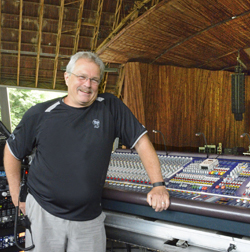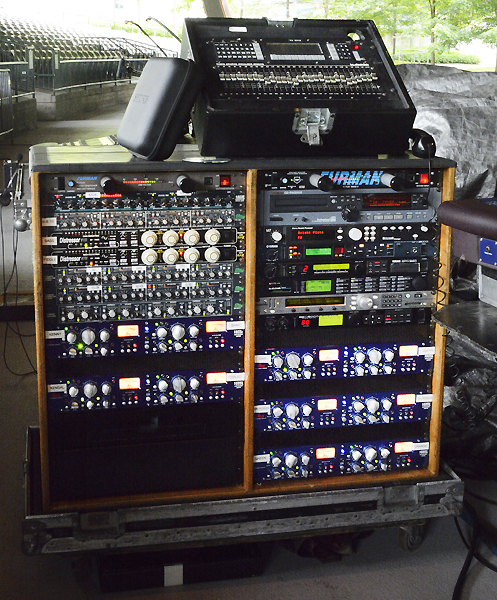
Methodical Approach
Even with “ears,” the nature of this band and the number of amps onstage make stage volume loud. Wireless channels total 24, with Shure UHF-R pulling the load on instruments and vocals.
Gould is the de facto wireless coordinator, with a Madell RF spectrum analyzer his instrument of choice to dial everything in.
“First I sweep the environment,” he says, explaining his tuning techniques. “If I see a number of TV stations, I know I’ll have to start turning things on and moving them around next. I’ll fire up one thing, look where it pops up on the analyzer, and just keep working my way down the line. I can see harmonics on the scope too, so I’ll move my frequencies accordingly to steer clear of trouble spots. If I get really lucky, I’ll move one transmitter frequency and a whole bunch of harmonics will disappear, fixing the problems entirely.
“Everyone seems to be moving to computer-based coordination, but I can see things in real-time this way, and it really takes no time at all for me to do RF. Another thing that’s important is every time I turn a unit on and fix it, I leave it on. If you turn things off as you go, you won’t see all the harmonics and problems will have a way of popping up.”

Paisley’s star-position, downstage center vocal mic is a Shure BETA 58A, an offering that suits his powerful, low/mid-centric voice. BETA 58As follow suit at all other vocal positions except for at Paisley’s stage left and right risers, out on the thrust, and at a FOH stage, where Shure KSM9s are found.
Drums are captured with a BETA 91 at kick, SM57s on snare, Sennheiser e604s on toms, and Audix SCX1 condensers on high-hat and overheads. SM57s stand-in once again for Paisley’s guitar cabinets, while Sennheiser MD 421s capture the sound of the steel guitar.
Experiencing Something
Gould uses Waves V9 plug-ins with his D-Show console, specifically the SSL console package that provides him with built-in compression on the channel strip. Echoing Freeman, he says, “I use very little compression. I’m like a 3:1 guy on everything, just enough to round-off the edges. I’m not trying to create sounds, just manage them.”
The tour thus far has been met with success at every stop, and included a night in Nashville opening for the Rolling Stones, a show that found Paisley joining the legendary rockers onstage performing “Dead Flowers.”
As he departs the production office at the Blossom Music Center, Freeman pauses to offer a final thought. “I like to make it big. Not so much loud, but big. I came into this job with the same attitude – big means you feel it, and that’s why you go to a concert in the first place. I obtain this bigness with subs, a lot of drums, bass guitar, and of course Brad is pretty adamant about having his guitar right in your face. We’re not making a record every night either.
“My goal is to send the audience home with the feeling that they experienced something rather than just sat back and listened.”
Gregory A. DeTogne is a writer and editor who has served the pro audio industry for more than 32 years.

